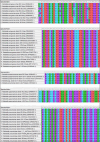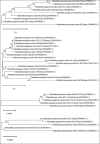Molecular identification of Klebsiella species from pneumonic goats, Iraq
- PMID: 39737024
- PMCID: PMC11682773
- DOI: 10.5455/OVJ.2024.v14.i11.26
Molecular identification of Klebsiella species from pneumonic goats, Iraq
Abstract
Background: In goats, acute and chronic respiratory infections are often characterized by a rapidly progressing clinical course with little opportunity to develop an effective antibiotic therapy.
Aim: This study aimed to identify Klebsiella spp. in pneumonic goats, assess its antibiotic susceptibility, and confirm the molecular phylogenetics of Klebsiella spp.
Methods: A total of 80 pneumonic goats were selected from the slaughterhouses located in Basra province (Iraq) from June to November 2023, and each animal was subjected to obtaining only one sample. The studied samples were included 30 nasal swabs obtained from the lived goats, while 30 lung samples in addition to 20 tracheal swabs were collected from slaughtered goats. All study samples were inoculated onto MacConkey agar and tested biochemically. Eleven types of antibiotics were served in the Kirby-Bauer disc diffusion method to identify the susceptibility of Klebsiella spp. Positive culture isolates were tested molecularly using the polymerase chain reaction (PCR) and then sequenced for phylogenetic analysis of study isolates.
Results: The findings indicated that 35% of samples were positive to Klebsiella spp. including 30% in trachea, 33.33% in nasal swabs, and 40% in lungs. Klebsiella colonies appeared on MacConkey agar as bright pink mucoid texture; while on blood agar, they were large, glossy, mucoid, whitish-grey, spherical, and free of hemolysis. Biochemically, all isolates were exhibited a negative reactivity to motility, oxidase, indole, and methyl red, but positives to urease, citrate utilization, catalase, and Voges-Proskauer, acid and gas production. Antibiotic susceptibility testing revealed the high susceptibility of Klebsiella isolates to meropenem (71.43%), and intermediate susceptibility to ciprofloxacin (28.57%), but high resistance to imipenem (60.71%). Targeting the 16S rRNA gene, PCR results confirmed all tested isolates as Klebsiella spp. Finally, phylogenetic analysis of 9 positive isolates demonstrated the identity of local Klebsiella isolates to Klebsiella aerogenes (no = 4), Klebsiella pneumoniae (no = 3), Klebsiella quasivariicola (no = 1), and Klebsiella quasipneumoniae (no = 1).
Conclusion: Our study confirms the presence of K. aerogenes, K. quasivariicola, and K. quasipneumoniae in pneumonic goats, highlighting the importance of molecular phylogeny in the detection of new Klebsiella species. However, furthermore studies are necessary to investigate various Klebsiella species/strains in goats and other domestic animals.
Keywords: Caprine pneumonia; K. aerogenes; K. pneumoniae; K. quasipneumoniae; K. quasivariicola.
Conflict of interest statement
The authors have declared no conflict of interest.
Figures




References
-
- Adam, M., Akeem, A.O., Barka, S.A., Olu, S.S.V., Abiodun, A.A. and David, O.F.S. (2023). Pathological and molecular investigation of some bacterial in the lungs and livers of red sokoto goats slaughtered at Ilorin, Kwara State, Nigeria. Med. Kedokteran Hewan, 34(2), 87–101.
-
- Aher, T., Roy, A. and Kumar, P. 2012. Molecular detection of virulence genes associated with pathogenicity of Klebsiella spp. isolated from the respiratory tract of apparently healthy as well as sick goats. Israel J. Vet. Med. 67(4), 249–252.
-
- Ahmed, B.A. and Abdullah, M.A. 2022. Isolation and molecular diagnosis of the main bacterial species causing Pneumonia in small ruminants in the Duhok Abattoir-Kurdistan region of Iraq. Microb. Biosys. 7(2), 66–73.
-
- Al-Ammiri, H.H., Abd-Allh, A.H. and Hamid, M. 2016. Isolation and identification of aerobic bacteria detected from sheep infected with pneumonia. Adv. Environ. Biol. 10(5), 214–220.
MeSH terms
Substances
LinkOut - more resources
Full Text Sources
Miscellaneous
